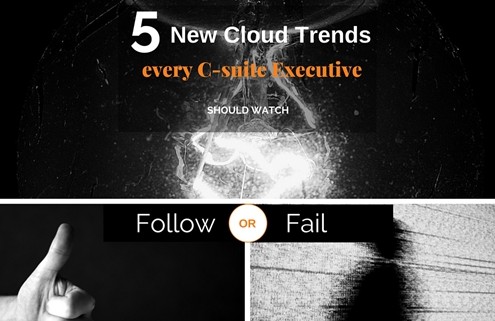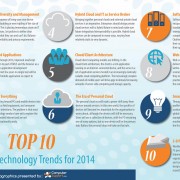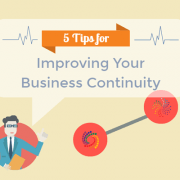Follow or Fail: 5 New Cloud Trends a C-suite Executive Should Watch
The cloud computing technology can easily be considered the most important platform for enterprises in the 21st century. The age of digital economy has put enormous amounts of data as drivers for many business decisions, activities, and processes. With cloud, companies have realized a number of competitive advantages such as cost efficiencies and data flexibility, putting them in the same league with many larger multinational corporations.
Now that cloud computing has gone mainstream with public cloud spending to exceed $52 billion by 2019 according to IT analyst company, IDC, in its last year’s research, the competitive advantages are beginning to diminish according to a new report from Harvard Business Review Analytic Services.
![]()
The benefits are starting to flatten out.
— Abbie Lundberg, contributing editor, HBR
Experts say that the reason for the cloud’s coming of age is because leaders are no longer applying cloud in strategic ways. A strategy is never a substitute for operational effectiveness as pointed out by Harvard strategy guru, Michael Porter.
![]()
Operational effectiveness (OE) means performing similar activities better than rivals perform them. Operational effectiveness includes but is not limited to efficiency. It refers to any number of practices that allow a company to better utilize its inputs by, for example, reducing defects in products or developing better products faster. In contrast, strategic positioning means performing different activities from rivals’ or performing similar activities in different ways
— Michael, E. Porter
This means that for company executives to reap the rewards of cloud computing on a sustainable level, they must invest in untapped markets and areas that can provide them with a sustainable competitive advantage. Here are five areas company executives must keep a lookout for.
Collaboration
Cloud computing has mainly been perceived for achieving significant cost efficiencies. However, a new direction among companies lies in collaboration. According to a report from HBR titled ‘Cloud: Driving a Faster, More Connected Business’, from a survey of more than 450 business and IT executives worldwide highlights that more than 70 percent of companies perceived collaboration as a major driver for cloud usage this year.
![]()
Business agility has been the number one driver for so long, but this time collaboration was just as high in terms of a benefit coming out of the use of cloud. That includes internal collaboration and collaboration with business partners and other stakeholders.
— Abbie Lundberg
Cloud collaboration is perceived very highly to allow various departments to work more closely together and strengthen cross-functional teams in diverse markets. The benefits of sharing data a lot quick across different departments can be instrumental in speeding up business processes and allow organizations to react to fluctuations in demand in real time.
Analytics
Analytics is another area that is attracting considerable attention from organizations. With the breadth of analytics opportunities pertaining to business intelligence and Big Data, business especially in the middle market sector are increasingly placing a lot of emphasis.
![]()
We’re seeing a continuing increase in the strategic importance of technology for middle-market companies. A lot of companies are starting to realize that technology is a fundamental way to reach out to their customers.
— Stephen Keathley, national technology leader, Deloitte Growth Enterprise Services
According to research from Deloitte, more than 60 percent of firms say their company executives have become interested in the implementation of next generation technologies while more than 40 percent are actively engaged. The rising spending on analytics is anticipated to make it the second most invested technology after cloud computing.
Cancer treatment
When we think of data analytics, we usually think of cracking numbers and extracting valuable insights to make better decisions for marketing and business strategy. However, with the scale of opportunities available today, analytics has important applications for the treatment of cancers. The Human Genome Project, the alternative to chemotherapy, was launched a number of years ago that involves tailoring treatment plan in accordance with a person’s specific disease by looking through the genetic, lifestyle, and environmental factors.
The downside of the project is that the precision treatment plan takes up to multiple weeks and months to formulate. Studying and analyzing the human DNA is very time-consuming, but with the help of data analytics software, the length of time can be reduced significantly. OSHU and tech giant Intel have announced a Collaborative Cancer Cloud, an open PaaS, that lets medical institutes to share genomic data about their patients that can be used to develop precision cancer treatment plans in just 24 hours.
![]()
The challenge now is that as more and more cancer genomes and more genomes for all diseases get sequenced, we’re facing a huge amount of data that’s getting generated. We need to be able to share this data in a way that allows us to decipher what it’s trying to tell us in a timely fashion.
— Brian Druker, Cancer Knight Institute director, OSHU
If emerging new analytics technologies can support the research, it will prove to be an important milestone for cloud computing in healthcare.
Hybrid clouds
Due to the rising concerns about data breaches, companies will be keen on switching to hybrid clouds. Hybrid clouds are, in essence, a combination of private and public cloud models in an attempt to keep confidential data on the former and non-essential data on the latter to keep a balance of both security and faster data accessibility. Hybrid cloud models are not simply an amalgamation of private and public models. In fact, it is a unique configuration between the two that allows companies to gain access to a number of tools for maximum leverage.
![]()
It’s better to be proactive and establish a framework for hybrid cloud now, so as new cloud services are introduced to the environment they have a home.
— Ed Anderson, Gartner Analyst
Growth of specialized cloud networks
Apart from hybrid clouds, specialized clouds are also gaining traction. As businesses mature and operate in specific industries providing specific products and services, the cloud models they base their operations on also change.
![]()
Because of government leadership in the specialized cloud sector, we’re starting to see many more traditional systems adopting specialized clouds. This is so they’re better prepared to provide an increased variety of cloud services.
— Wing Kin Leung, CTO, Huawei
Organizations such as the government, for instance, require a hybrid cloud network with a specific requirement of storing data locally. This plays an important part in making the cloud model specific for government organizations as opposed to a multinational corporations.
End note
Cloud, as with any technology, is bound to lose its competitive edge unless company executive find more strategic ways of leveraging the technology. This requires anticipating future cloud applications, market projections, and most important of all, a continuous search for doing things differently.






